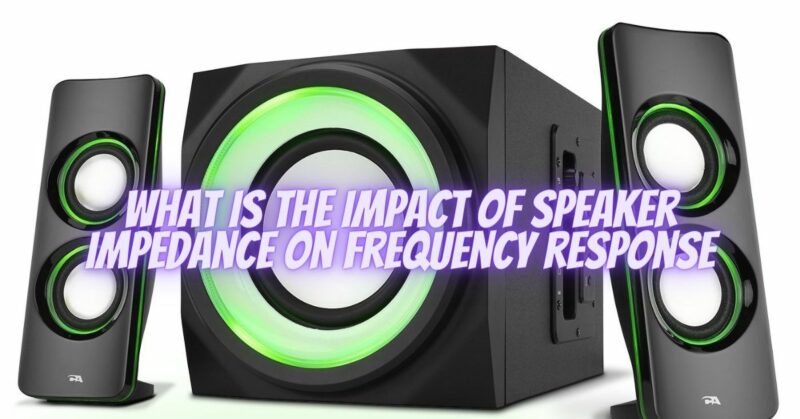Speaker impedance is an essential characteristic that influences the electrical behavior of a speaker and plays a significant role in shaping its frequency response. Understanding the impact of speaker impedance on frequency response is crucial for achieving accurate and balanced audio reproduction. In this article, we will explore the relationship between speaker impedance and frequency response, shedding light on how impedance variations affect the way speakers handle different frequencies.
- Understanding Speaker Impedance:
Speaker impedance is a measurement of the opposition that a speaker presents to the flow of alternating current (AC) electrical signals. It is typically measured in ohms (Ω). The impedance of a speaker can vary across the frequency spectrum due to the complex nature of the speaker’s electrical and mechanical components.
- Impedance Variation with Frequency:
Speakers exhibit impedance variations with frequency due to several factors, including the driver design, crossover network, and enclosure characteristics. The impedance curve of a speaker typically features peaks and dips at different frequencies.
a. Resonant Frequency: One notable impedance peak occurs at the resonant frequency of the speaker. This is the frequency at which the driver’s mechanical resonances come into play, causing a peak in the impedance curve. The resonant frequency is typically in the lower end of the speaker’s frequency range.
b. Crossover Frequencies: Another area where impedance variations occur is around the crossover frequencies, where different drivers transition responsibility for reproducing specific frequency ranges. These impedance variations are influenced by the crossover network design and the characteristics of the individual drivers.
c. Enclosure Effects: The type of speaker enclosure can also affect the impedance response. For example, a bass reflex (ported) enclosure may exhibit impedance dips or peaks related to the tuning of the port and the interaction between the speaker and the enclosure.
- Impact on Frequency Response:
The impedance variations of a speaker can have a significant impact on its frequency response. These variations affect the way the speaker interacts with the amplifier driving it and can influence the energy transfer and damping characteristics.
a. Frequency Response Irregularities: Impedance peaks and dips can cause irregularities in the speaker’s frequency response. At frequencies where the impedance is high, the speaker may be less efficient in converting electrical energy into sound, resulting in reduced output levels. Conversely, at frequencies where the impedance is low, the speaker may draw more power from the amplifier, potentially leading to distortion or overloading.
b. Amplifier Compatibility: Matching the amplifier’s output impedance to the speaker’s nominal impedance can help ensure optimal power transfer and minimize potential frequency response irregularities. Amplifiers with a relatively low output impedance are generally better suited for driving speakers with varying impedance characteristics.
- Speaker and Amplifier Interaction:
The interaction between the speaker’s impedance and the amplifier’s output impedance is crucial. The amplifier’s ability to control the current and voltage delivered to the speaker is influenced by the speaker’s impedance characteristics. A speaker with a highly varying impedance curve may demand more from the amplifier, particularly in terms of current delivery, to maintain accurate frequency response.
- Speaker Design and Compensation:
Speaker manufacturers often design and compensate for the impedance variations in their products. They may employ techniques like crossover network design, driver selection, and enclosure tuning to mitigate frequency response irregularities and maintain a more consistent output across the audible frequency range.
Conclusion:
The impedance characteristics of a speaker play a significant role in shaping its frequency response and overall performance. Impedance variations, including peaks, dips, and resonant frequencies, can lead to irregularities in the frequency response, affecting efficiency, power handling, and overall sound quality. Understanding these impedance variations and their influence on frequency response helps in selecting suitable amplifiers, optimizing the speaker-amplifier interaction, and achieving accurate and balanced audio reproduction. When choosing speakers and amplifiers, it is essential to consider impedance compatibility and seek products that are designed to mitigate the impact of impedance variations. By doing so, you can ensure that your audio system delivers faithful and consistent sound reproduction across the entire frequency spectrum.


